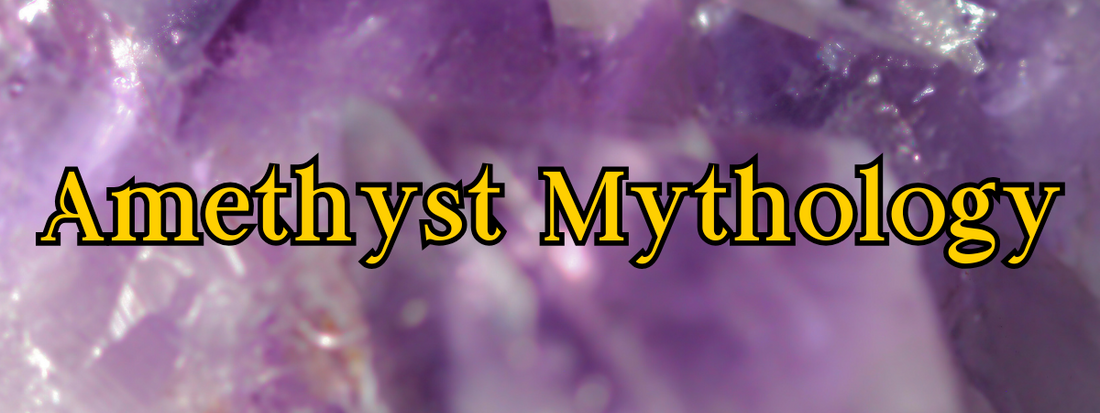
Amethyst Myths and Legends: A Gemstone of Protection, Spirituality, and Royalty
Amethyst has captivated cultures for centuries. Its striking purple hues and deep symbolic meaning make it one of the most revered gemstones. Across different civilizations, amethyst has been linked to protection, spirituality, and divine favor. From ancient myths to modern metaphysical properties, this gemstone has left an enduring mark on human history.
 Amethyst in Greek and Roman Mythology
Amethyst in Greek and Roman Mythology

One of the most well-known legends surrounding amethyst comes from Greek and Roman mythology. The story tells of Bacchus (Dionysus in Greek version), the god of wine, who, in a fit of anger, vowed to punish the next mortal he encountered.
This happened to be a maiden named Amethyst, who was on her way to worship at the temple of Diana (or Artemis). To protect her from the gods wrath, the goddess transformed Amethyst into a statue of pure quartz. Overcome with remorse, Bacchus poured his wine over the statue, staining it a deep purple and thus creating the gemstone we now know as amethyst.
This tale is believed to be the reason for the belief that amethyst could prevent intoxication. For centuries, the gemstone was worn or used in goblets to keep drinkers sober. However, this tale is not an ancient myth, it was created in the Renaissance era by the French poet Rémy Belleau. Leaving the real reason for this gems links to sobriety lost to history.
If you’re interested in a deeper dive into this fascinating tale, check out
The Legend of Bacchus and Amethyst
 Amethyst in Ancient Egypt
Amethyst in Ancient Egypt
Egyptians believed amethyst could ward off negative energy and safeguard the wearer from harm. Pharaohs and high-ranking officials adorned themselves with amethyst jewelry, not only for its beauty but also for its supposed ability to provide courage and strength.
Cleopatra had an amethyst signet ring that was said to be engraved with the figure of the Persian god of the divine idea. One of the reasons she wore this ring was for the sobering effect she believed amethyst possessed.
Additionally, the Egyptians had a charm to protect against sorcery and gout (yes, I thought this was a strange combination too). This charm involved tying an amethyst and a swallow feather around ones neck with the hair from a peacock.
 Amethyst and Roman Beliefs
Amethyst and Roman Beliefs
Amethyst, being widely accepted as a gemstone of protection and courage in Ancient Rome, was a gem of choice for soldiers. But the Ancient Romes didn't just believe in the powers of gemstones, they also believed different metals had various energies too.
Copper, which was closely associated with the goddess Venus, was thought to have protective and healing properties.
For a Roman soldier, an amethyst set in copper was the ideal talisman. Not only did the copper and amethyst offer their own individual protective energies, it was thought the metal would amplify the gemstones powers, making a copper charm set with amethyst the ultimate battle companion.
 Amethyst in Tibetan Buddhism
Amethyst in Tibetan Buddhism
Tibetan monks have long revered amethyst as a sacred stone. It is often used in prayer beads (mala) to aid meditation and spiritual enlightenment.
The gemstone is believed to help calm the mind, enhance concentration, and deepen one’s spiritual connection. Even today, amethyst malas are widely used in Buddhist practices for their soothing and transformative properties.
 Amethyst in Hinduism
Amethyst in Hinduism
In Hindu traditions, amethyst is associated with the crown chakra, the energy center linked to spiritual awareness and higher consciousness. It is believed to help remove negative thoughts, enhance wisdom, and promote a sense of peace and clarity during meditation.
 Amethyst in Chinese Traditions
Amethyst in Chinese Traditions
In Chinese culture, amethyst has been used in Feng Shui practices to clear negative energy and promote balance. It is often placed in homes and businesses to attract positive energy and dispel harmful influences. Chinese practitioners also believe that amethyst can aid in emotional healing and help maintain harmony in relationships.
 Amethyst in Medieval Europe
Amethyst in Medieval Europe
During the Middle Ages, amethyst was associated with purity and devotion. It was frequently worn by clergy members, including bishops, as a symbol of celibacy and divine wisdom.
Beyond religious significance, medieval soldiers carried amethyst amulets into battle, much as the Ancient Romans did. They believed the stone would grant them protection and keep them level-headed in the chaos of war.
 Amethyst and Royalty
Amethyst and Royalty
Throughout history, amethyst has been regarded as a stone of nobility. European royalty often incorporated amethyst into their crowns, scepters, and jewellery as a symbol of power and divine favor.
Even in modern times, amethyst remains a popular gemstone among royalty and collectors alike.
 A Timeless Gem
A Timeless Gem
From ancient myths to modern spirituality, amethyst has held a place of reverence in human culture for millennia. Whether worn for protection, used in spiritual practice, or simply admired for its beauty, this remarkable gemstone continues to inspire and enchant.
